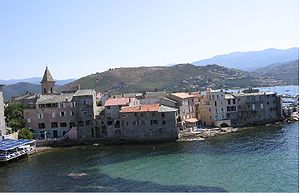Muscat du Cap Corse
The Muscat du Cap Corse wine-growing region is an appellation on the French island of Corsica . Only fortified, white dessert wines with residual sweetness are marketed under this name . The wine belongs to the Vin Doux Naturel family .
The area has had the status of an Appellation d'Origine Contrôlée (AOC for short) since March 26, 1993 , making it the youngest of the appellations in Corsica. Approved vineyards are in the Cap Corse area in the 17 municipalities of Barbaggio , Barrettali , Cagnano , Centuri , Ersa , Farinole , Luri , Méria , Morsiglia , Oletta , Patrimonio , Pietracorbara , Poggio d'Oletta , Rogliano , Saint-Florent (but only the Areas on the right side of the Aliso stream), Sisco and Tomino . The area is an enclave within the appellations Patrimonio and Vin de Corse - Coteaux du Cap Corse in the north of the island, not far from Bastia .
The wines are sorted from the vine Muscat blanc à petits grains expanded. The golden yellow wine has a fine nose and, depending on the producer, a more or less intense nutmeg aroma. The appeal regulations require that the must has at least 252 g / l natural sugar before fermentation . This corresponds roughly to a selection quality with a must weight of 103 degrees Oechsle and the wine would achieve an alcohol content of at least 15 percent by volume when fully fermented . However, the natural fermentation process is stopped when a residual sweetness of at least 95 g / l is reached by adding pure alcohol and brought to at least 16% by volume.
The yield limitation is a low 30 hl / ha. The still young appellation is developing slowly due to the specific product. In 1996, 66 hectares of vineyards were known. Currently (2006) the declared area under vines is around 98 hectares. The trend is still increasing. Due to the low yields, which are in real terms around 25–26 hl / ha, the annual production volume is around 300,000 bottles per year.
See also
literature
- Hubrecht Duijker : The best wines - Rhône and southern France . Albert Müller Verlag, Zurich, Stuttgart, Vienna 1983, ISBN 3-275-00891-9 , 1 / 8-86.
- Jancis Robinson : The Oxford Wine Lexicon, 3rd revised edition . 1st edition. Gräfe and Unzer Verlag, Munich 2007, ISBN 978-3-8338-0691-9 .
- Pierre Galet : Cépages et Vignobles de France (French language) . 1st edition. Lavoisier publishing house, 2004, ISBN 2-7430-0585-8 .
- Benoît France: Grand Atlas des Vignobles de France (French language) . 1st edition. Éditions SOLAR, 2002, ISBN 2-263-03242-8 .

